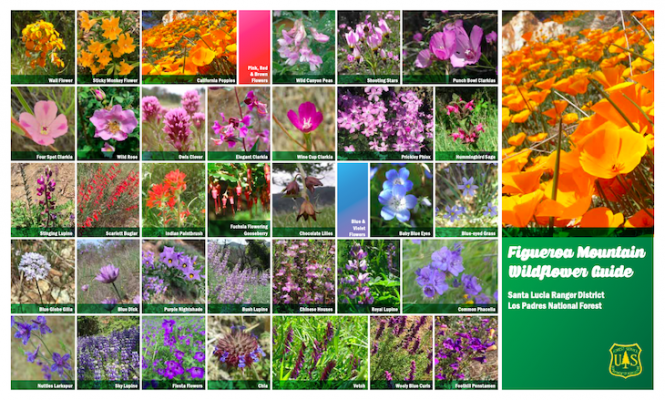Hello everyone! Welcome to the 2024 Figueroa wildflower season!
Well, spring has sprung, and the wildflowers are starting to do the same. While most of the flowers are currently in the lower elevation, some of the early varieties are starting to bloom in higher elevations as well.
Let’s get going and see what we find!
Starting at the first cattle guard and continuing to the canopy area, shiny buttercups, lovely fiesta flowers, blue dick, fiddleneck, filaree, toothwort, a few sky lupine, lomatium, Johnny jump-ups, shooting stars and popcorn flowers can be found.
As you approach the canopy area, start looking for Johnny jump-ups, miner’s lettuce hummingbird sage, popcorn flower, sky lupine, lomatium, shooting stars, fiddleneck, filaree, blue dick, buttercups and fiesta flowers. The Henbit deadnettle has returned this year. While this plant is not native and could be considered invasive, let’s remember that it is quite beneficial by providing nectar to the pollinators and foliage to the wildlife. The adorable tiny flowers of this mint family plant appear to have a cute face which somewhat resembles a bunny or a fox or what does it look like to you? Tell me what you think it resembles. While there aren’t very many of them, look for them in the grassy shady areas along this stretch.
As you continue to climb the mountain, stunning orange California poppies are starting to bloom along the road and on the rocky hillsides. Right before the rusty gate, sweet cream cups are in bloom, however, they are very few and quite small. Continuing up the hill, keep an eye out for mustard, Ceanothus, gorgeous orange California poppies, wild cucumber, miner’s lettuce, buttercup, blue dick, the start of fiddleneck, popcorn flower, fillaree, lomatium, coreopsis and shooting stars. There are a couple of areas in the distance, along the lower part of the mountains where one can see carpets of goldfields. In the moist, shaded areas along the rocky hillsides, wild canyon peas are also starting to bloom.
As you’re going up the road, look to your left and note that Grass Mountain is still grassy. No signs of orange or purple are visible yet.
At Vista Point (large gravel turnout about 11.4 miles from the bottom), the grass is lush and green but look closely and you will find quite a few chocolate lilies scattered within the grass. Shooting stars are also plentiful in this area. Look for goldfield, fillaree, lomatium and fiddleneck as they are starting their bloom. I also spotted some fool’s onion towards the rock outcrop as you walk down the dirt path.
In the area across Vista Point and along the road to the fire station, things are starting to bloom there as well. Look for lomatium, poppies, blue dick, coreopsis and popcorn flower.
Beyond the station, few wildflowers were spotted until one gets to the field on the right before Tunnel Ranch Road. Even here, only a handful of buttercups and shooting stars are in bloom along with a couple of charming little wallflowers which arrived before any others.
Approximately half a mile further, the famous poppy hillside is waking up. The poppies are in great abundance and carpeting the hillside more and more each day. The same with the lupine. There are sweet-smelling lupine popping up as well. The hillside is covered in lupine plants with lots and lots of wee little buds, so the lupine, like the poppies should be carpeting this hillside very quickly.
Beyond this area and to the Davy Brown Trailhead, only poppies, a few lupine, Ceanothus and a couple of bush lupine are in bloom. Beyond the trailhead, the grassy fields leading up to the bottom of Ranger Peak are showing off the plethora of shooting stars! This is definitely a shooting star year. Also look for buttercup, lomatium and beautiful manzanita bushes in bloom.
This gets us into the higher elevation area where the flowers aren’t ready to show off yet. From the bottom of Ranger Peak and over to the other side, only miner’s lettuce was spotted. A scarce number of baby blue eyes are waking up and beginning to open their adorable blooms. These cuties, along with others in this area, are taking their time because the nights are still quite chilly in the higher elevations. From Ranger Peak to Cachuma Saddle only a handful of poppies were spotted and a couple of tree poppies were beginning their bloom.
Sunset Valley is also just waking up. Aside of a few areas that are starting to get patches of small yellow poppies, not much more is in bloom except for limited numbers of popcorn flower, wild cucumber, buttercups, blue dick and the very beginning of tree poppies and prickly phlox.
Happy Canyon has about the same amount of wildflowers as Sunset Valley. As you head out Happy Canyon, you’ll see very little flowers and those are far and few between. You’ll spot occasional poppies, popcorn flower, blooming Ceanothus, buttercups, coreopsis, blue dick, shooting stars and lupine.
We respectfully request that when coming out to see the wildflowers, please do not stop or park in the middle of the road nor block any part of the road, as this hinders traffic and creates traffic congestion. In the event of an emergency, this would prevent emergency vehicles from getting through.
That’s all for this update. Look for our next wildflower update in two weeks. Until then, happy viewing! If you would like to be added to the Figueroa Wildflower Update email list, please send your request to Helen Tarbet by email at helen.tarbet@usda.gov.








